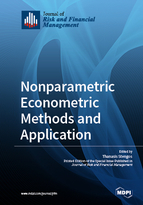Nonparametric Econometric Methods and Application
A special issue of Journal of Risk and Financial Management (ISSN 1911-8074). This special issue belongs to the section "Mathematics and Finance".
Deadline for manuscript submissions: closed (31 March 2019) | Viewed by 60916
Special Issue Editor
Interests: nonparametric econometrics; applied time series models; empirical finance; empirical growth
Special Issues, Collections and Topics in MDPI journals
Special Issue Information
Dear Colleagues,
An area of very active research in econometrics over the last 30 years has been that of non- and semi-parametric methods. These methods have provided ways to complement more-traditional parametric approaches in terms of robust alternatives, as well as preliminary data analysis. The field has expanded with important advances both in time series and cross sectional frameworks and more recently in panel data settings, allowing for data driven flexibility that has proved invaluable to applied researchers. The methodology has been enhanced by software developments that have made these methods easy to apply, somethings that has opened up a variety of potentially important and relevant applications in all areas of economics, microeconomics, macroeconomics and economic growth, finance, labor, etc. The present Special Issue aims at collecting a number of new contributions both at the theoretical level, as well as in terms of applications. We hope that this collection of papers will add to this important literature, both at the theoretical and empirical level including areas, such as local smoothing techniques, splines, series estimators, and wavelets.
Prof. Dr. Thanasis Stengos
Guest Editor
Manuscript Submission Information
Manuscripts should be submitted online at www.mdpi.com by registering and logging in to this website. Once you are registered, click here to go to the submission form. Manuscripts can be submitted until the deadline. All submissions that pass pre-check are peer-reviewed. Accepted papers will be published continuously in the journal (as soon as accepted) and will be listed together on the special issue website. Research articles, review articles as well as short communications are invited. For planned papers, a title and short abstract (about 100 words) can be sent to the Editorial Office for announcement on this website.
Submitted manuscripts should not have been published previously, nor be under consideration for publication elsewhere (except conference proceedings papers). All manuscripts are thoroughly refereed through a single-blind peer-review process. A guide for authors and other relevant information for submission of manuscripts is available on the Instructions for Authors page. Journal of Risk and Financial Management is an international peer-reviewed open access monthly journal published by MDPI.
Please visit the Instructions for Authors page before submitting a manuscript. The Article Processing Charge (APC) for publication in this open access journal is 1400 CHF (Swiss Francs). Submitted papers should be well formatted and use good English. Authors may use MDPI's English editing service prior to publication or during author revisions.
Keywords
- Nonparametric methods
- Semiparametric methods
- Local smoothers
- Splines
- Wavelets
Benefits of Publishing in a Special Issue
- Ease of navigation: Grouping papers by topic helps scholars navigate broad scope journals more efficiently.
- Greater discoverability: Special Issues support the reach and impact of scientific research. Articles in Special Issues are more discoverable and cited more frequently.
- Expansion of research network: Special Issues facilitate connections among authors, fostering scientific collaborations.
- External promotion: Articles in Special Issues are often promoted through the journal's social media, increasing their visibility.
- Reprint: MDPI Books provides the opportunity to republish successful Special Issues in book format, both online and in print.
Further information on MDPI's Special Issue policies can be found here.





